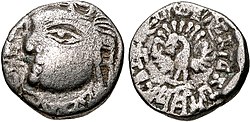Ishanavarman
Iśanavarman was the first independent Maukhari ruler of Kannauj. He was a very powerful king, and adopted the title of Maharajadhiraja.
| Ishanavarman | |
|---|---|
| Maharajadhiraja | |
 Coin of King Iśanavarman of the Maukhari of Kannauj | |
| 1st independent Maukhari ruler of Kannauj | |
| Reign | c. 550-560 CE |
| Predecessor | Ishvara-varman |
| Successor | Sharva-varman |
| Spouse | Mahadevi Lakshmivati |
| Issue | Sharva-varman, Suryavarman |
| Dynasty | Maukhari |
| Father | Ishvara-varman |
Early lifeEdit
Ishanavarman was the son of the powerful Maukhari ruler Ishvara-varman (Iśvaravarman) and his queen Devi Upagupta. He was well known for his skill as an archer, particularly against enemy cavalry and elephants. Ishanavarman ascended the throne in 550 CE or 554 CE, probably after his father's death.[1][2]
ReignEdit
The early Maukhari rulers had been on very friendly terms with the Later Guptas, and even conducted marriage alliances between themselves. An example is Ishanavarman's own mother Devi Upagupta, who was married to Ishvara-varman. However, things changed with time under him. Under Ishanavarman, the Maukharis began to assert their independence from the Later Guptas. Ishanavarman became hostile to the former overlords of the Maukharis, in order to conquer Magadha.[1]
Ishanavarman revived the Maukhari power, as some prestige was lost during the last years of his father's reign. Ishanavarman's inscriptions describe him as a valiant warrior whose hands were hardened and callused by the repeated use of the bow on the battlefield. His armies are stated to be vast and continuously on the march. The Haraha inscription of Śarva-varman mentions that Ishanavarman inflicted defeat upon the Andhras, Sulikas, and checked the Gaudas. The Andhra country was then ruled by the Vishnukundinas. The Vishnukundina king defeated must have been Indravarman or Vikramendravarman I.[3]
Ishanavarman in all probability would have taken much pains to reorganize the Maukhari army and make it strong and worthy. His successful campaigns against foes known for their powerful corps - the Andhras for their elephants and the Sulikas for their cavalry - attest to this fact. The Maukharis developed into a prominent and imperial power during his reign. He was also the first Maukhari ruler to adopt the title of Maharajadhiraja.[1]
The Mahakuta Pillar inscription claims that Chalukya Kirtivarman I defeated the rulers of Vanga, Anga, Kalinga, Vattura, Magadha, Madraka, etc.[4] In their northwards expansion, the Chalukyas probably came into conflict with Ishanavarman and suffered a defeat at his hands.[5]
The victories of Ishanavarman increased the political power of the Maukharis and alarmed the Later Gupta king Kumaragupta III who defeated Ishanavarman but could not completely crush him.[1]
Personal lifeEdit
He was married to Mahadevi Lakshmivati, and had two children- Sarvavarman and Suryavarman.[1][6]
SuccessionEdit
Ishanavarman was succeeded by his eldest son Sarvavarman in 560.[1][6]
ReferencesEdit
- ↑ 1.0 1.1 1.2 1.3 1.4 1.5 Lal, Avantika. "Maukhari Dynasty". World History Encyclopedia.
- ↑ Tripathi, Rama S. (1989). History of Kanauj: To the Moslem Conquest. Motilal Banarsidass Publ. p. 39. ISBN 9788120804043.
- ↑ Tripathi, Rama S. (1989). History of Kanauj: To the Moslem Conquest. Motilal Banarsidass Publ. p. 40. ISBN 9788120804043.
- ↑ Narayanan, M. G. S. Perumāḷs of Kerala: Brahmin Oligarchy and Ritual Monarchy: Political and Social Conditions of Kerala Under the Cēra Perumāḷs of Makōtai (c. AD 800 - AD 1124). Thrissur (Kerala): CosmoBooks, 2013. 90.
- ↑ Tripathi, Rama S. (1989). History of Kanauj: To the Moslem Conquest. Motilal Banarsidass Publ. p. 42. ISBN 9788120804043.
- ↑ 6.0 6.1 Tripathi, Rama S. (1989). History of Kanauj: To the Moslem Conquest. Motilal Banarsidass Publ. p. 44. ISBN 9788120804043.